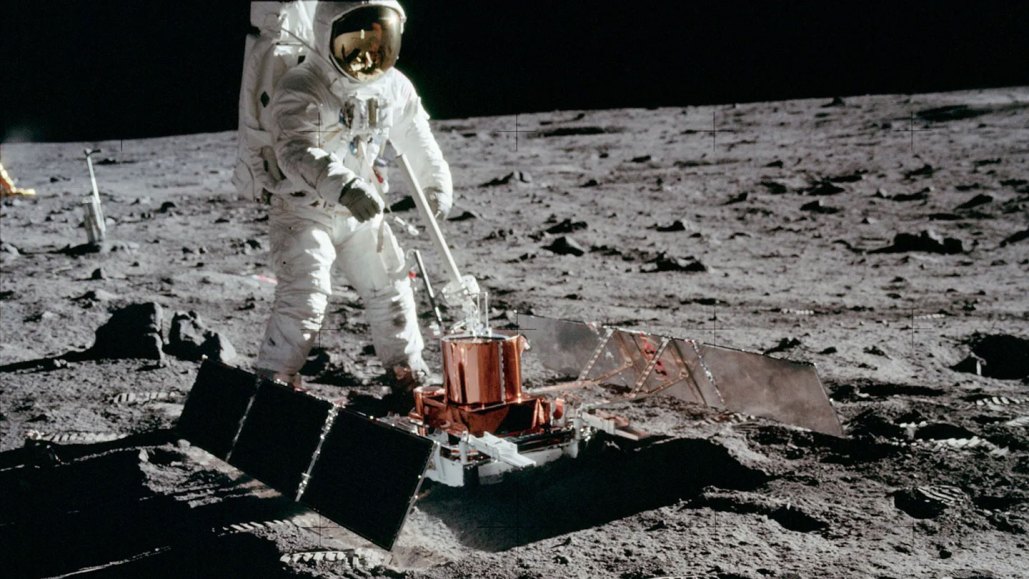New Apollo Data Reveals Moonquakes Far More Frequent Than Previously Believed

A new look at decades-old data from the Apollo missions has uncovered evidence of tens of thousands of previously unrecognized moonquakes. The results could reveal details about the moon’s inner workings and could have implications for future human missions.
“There were more tectonic events on the moon, it’s more tectonically active than considered before,” says planetary seismologist Keisuke Onodera of the University of Tokyo. By meticulously examining the shapes of seismic waves, Onodera found 22,000 never-before-seen moonquakes, he reports July 5 in JGR: Planets.
In the 1960s and 1970s, the Apollo missions that landed on the moon brought along two kinds of seismometers: one to measure longer-period seismic waves that originated deeper underground, and one to measure shorter-period waves that began closer to the surface or that carried more energy (SN: 7/15/19).
The seismometers draw the shape of the waves that shake the ground — some are squat and dampen quickly, while others are long and taper out. Based on the shapes, scientists can learn about the origins of the quake.
Some of those seismometers took data nearly continuously from 1969 through 1977, recording about 13,000 seismic events (SN: 5/13/19). But most of the data from the short-period seismometers was so contaminated with other sources of waves, it was almost unusable at the time.
“These are 50-year-old data that people had to deal with basically by hand,” says California-based lunar seismologist Ceri Nunn, who was not involved in the new study. “You’d print them out on a crappy old dot matrix printer and draw it up by hand.”
So lunar scientists knew that they were probably missing some moonquakes from that time period. But nobody had actually sat down and cleaned up the data to find out how many, until Onodera turned his attention to it last year.
“The most surprising thing is I detected 22,000 — a much larger number of events than the original dataset,” Onodera says. The new quakes bring the total known number to 35,000. “That’s something nobody expected.”
Onodera looked at the graph of each individual seismic event by eye, and categorized them one by one based on its shape. Other lunar scientists were impressed by this low-tech meticulousness.
“It’s natural intelligence, I would say, not artificial intelligence,” says planetary geophysicist Raphaël Garcia of ISAE-Supaero in Toulouse, France, who was not involved in the study. “I’m sure it’s a huge amount of work. He reprocessed everything.”
Seismologist Keisuke Onodera classified different seismic wave shapes that correspond to shakes of different origins. Impacts on the moon created a bushy waveform (top) that shook the ground at speeds of a few hundred nanometers per second, and lingered for 30 minutes. Shallow moonquakes made a shorter blip that tapered quickly (bottom). Categorizing the quakes from different sources gives new insight into the moon’s seismic activity.
Comparing waveforms made by different kinds of moonquakes
Most of the newly identified quakes were from external sources like extreme temperature changes or impacts, including times when NASA deliberately dropped rocket boosters or lunar modules on the moon’s surface to see what they did. But some were shallow moonquakes that reflect motions originating in the upper few kilometers of the moon’s crust. These quakes are the ones most likely to give information about the moon’s inner workings.
Previous studies had identified 28 shallow moonquakes over eight years of observations. Onodera found 46 more, significantly increasing the total number of known shallow moonquakes.
He also found that these shallow quakes seemed to be more common in the northern hemisphere, near the Apollo 15 landing site, than near the more southerly Apollo 14 and 16 sites. Gravity data from the NASA GRAIL probes, which smashed into the lunar surface in 2012, showed that volcanic dikes surround the Apollo 15 site as well (SN: 12/14/12). The shallow moonquakes may form when the moon’s crust contracts around these denser intrusions, Onodera suggests.
Getting a better handle on lunar quakes’ frequency and strength will be important in planning human trips to and structures on the moon. Seismic data can help measure the depth of lunar soil, which can determine how much building material astronauts will have to work with. The measurements can also set limits for how much shaking lunar habitats need to withstand, and indicate where the safest landing sites might be.
Luckily, lunar scientists should soon have much more data to work with. NASA and commercial partners are planning to send a pair of seismometers to the farside of the moon in 2025. And the Chinese Chang’e 7 mission will send another seismometer to the lunar south pole in 2026.




